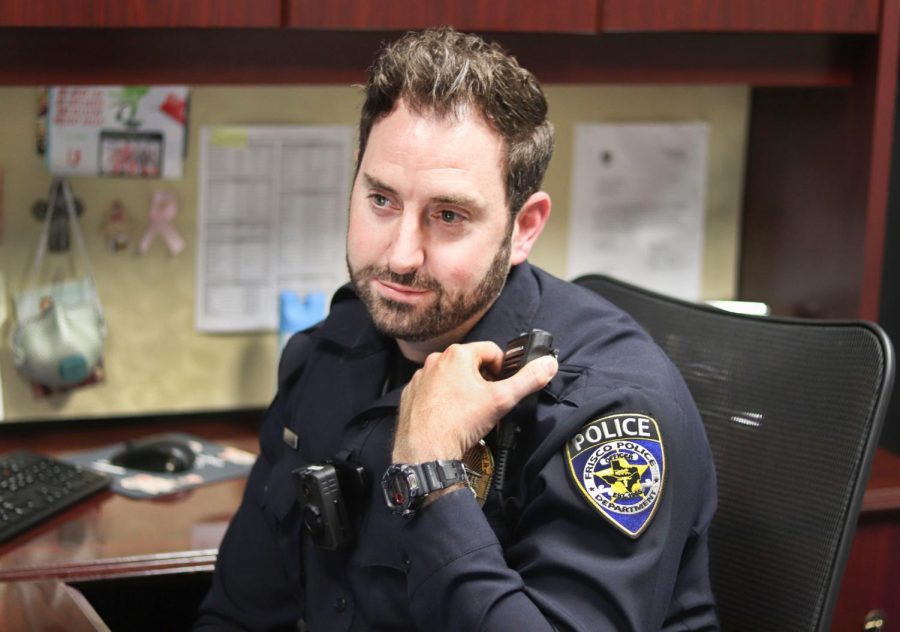Law and order in session
As calls for defending the police swept across the nation, reform advocates urged it to extend into schools. But are School Resource Officers necessary for student safety and crime reduction?
November 19, 2020
Students from kindergarten through 12th grade are constantly under the eyes of officers, a fact that comforts some and unnerves others across America. School resource officers are the men and women walking the halls during passing periods, watching over students and posted at the entrance of football games.
They also have the authority to arrest students for criminal offenses committed on campus.
After the rise of school shootings, lawmakers and taxpayers alike pushed for more officers or security presence in schools, especially following the massacre at Marjory Stoneman Douglas High School in Parkland, Fla.
But, after the surge of protests surrounding police brutality across the nation in the summer, critics of criminal justice have questioned the presence of SROs in schools. In fact, calls across the nation to “defund the police” have reached the ears of school boards, pushing some to reform funding.
Closer to Home
Jeremy Petty, the school resource officer for the past five years at Heritage, says his goal as an SRO is to protect students from gun violence or any other terroristic threats.
In terms of his secondary goal, he said he makes it his job to teach and spread love and objectivity.
“It’s important to teach students how to love instead of hate,” Petty said. “I do not judge you by your skin tone. Therefore you should not judge me by my uniform. We are all humans.”
He tries his best to get to know as many students and help students feel comfortable around him and in the school building.
This works for a majority of students in America, according to a report by the National Assessment of School Resource Officers.
76 percent of students have said they feel safer when there is an SRO present, the report said. With Officer Petty in the building, students can learn with reassurance they are protected, some students say.
“Having an officer on campus helps me feel safer inside my learning environment,” senior Zoey Young said.
Petty also shares how much improvement has occurred within our schools in the time he has been here. “Since I’ve been at Heritage, the amount of crime occurring on campus has drastically decreased,” Petty said.
He attributes this drop in crime to enforcing a no-tolerance policy that would allow him to arrest any student caught fighting on campus or with e-cigarettes or a vaping device. Once he started busting students for small offenses, he said gradually he saw less and less crime on campus.
“I can personally say that with SROs inside of schools, kids are less likely to make decisions they will end up regretting,” Petty said.
Overall, Officer Petty argues that SROs are crucial to helping de-escalate and prevent school violence. He said having an officer on campus who is able to respond quickly to any conflicts can halt a bad situation — and in a worst-case scenario, stop an active shooter.
Police in schools
But according to the American Civil Liberties Union, the presence of school resource officers on campus have shown to negatively affect students, arguing that students should be “educated, not incarcerated.” A 2016 ACLU study showed that students with disabilities were more likely to face suspension than students without. The group argues that instead of policing students, schools should provide access to resources and counseling to curb the effects of neglect, abuse and poverty.
Jacqueline Caspari, a Student Support Coordinator of FISD, believes that there are consequences of having police inside of schools and argues for changes in the support provided for students.
“The penal code and school system is failing our kids because they can’t provide the support students need in court,¨ Caspari said. Support would look like providing a lawyer or an after-educational path to get them back to learning. Without this support, kids fall through the education system and into a criminal one, Caspari said.
Those in opposition of the SRO system believe that police do not make schools safer — they reinforce the criminalization of young people of color instead.
According to the U.S. Department of Education Office for Civil Rights, in 2016 “on average, 5% of white students are suspended, compared to 16% of black students.” The data also reveals disproportionate rates for Native-Alaskan and American Indian student suspensions and expulsions.
Another topic activists have brought up is the reports of students with mental illnesses who are more likely to get into police-involved situations.
“If there is a student who has a mental illness and is not getting the help they need, they can be unintentionally affected,” Caspari said.
Junior Madelyn Richardson believes that SROs, in general, are unnecessary, saying that school shootings are an issue but most are caused by undiagnosed and untreated mental illnesses.
¨The school should fund more training for mental health officials and prevent these issues from happening rather than having an officer to stop them when they do,¨ Richardson said.
Some activists are starting to lobby for changes in how schools fund support services, including Frisco ISD’s move to increase funding for counselors on campus.
Caspari said she thinks that police should remain in schools but believe that there should be more required training along with events with the SRO to help students feel more comfortable around their presence.
“Over everything else, I think there needs to be more opportunities for counselors and SROs to reach out to kids and stop conflicts before kids get into trouble,” Caspari said.



